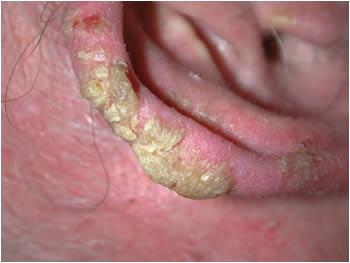What is Actinic Keratosis - definition, symptoms and treatment

Actinic Keratosis - Precancerous growths (lesions) on the SKIN, also called solar keratosis, that develop as a consequence of damage from overexposure to the sun. Actinic keratosis becomes more common with advancing age. Lesions are most common on the face, scalp, chest, hands, and arms though can develop anywhere on the body that receive extensive sun exposure. In their early stages, the lesions appear scaly and rough, and bleed easily. In later stages, the lesions acquire a wartlike appearance. Most squamous cell SKIN CANCER arises from actinic keratosis. Removing the lesions prevents them from developing into CANCER. Between 10 and 20 percent of untreated actinic keratosis develops into squamous cell skin cancer, though it is not possible to determine which lesions will remain benign and which will turn cancerous.
Symptoms of Actinic Keratosis and Diagnostic Path
The lesions of actinic keratosis follow a typical and consistent progression of symptoms. Actinic keratosis begins with a small, scaly patch of skin that may itch. It often appears to heal or peel off, then recurs. The LESION may be grayish, may reddened (erythematous), or may be the same color as the skin. Most people first feel rather than see the lesion. As changes to the skin cells at the site continue, the lesion becomes more defined and apparent. The lesion may resemble a wart, or may become hardened and overgrown, developing a tough, thick texture (hyperkeratosis).
Because the progression of actinic keratosis is so characteristic, the dermatologist generally makes the diagnosis on the basis of appearance and history of sun exposure. The dermatologist may choose to biopsy larger or suspicious lesions to determine whether they have progressed to squamous cell skin cancer. Unless such suspicion exists, there is no need for biopsy because the standard treatment of Actinic Keratosis is to remove the lesion, which consequently eliminates the lesion’s risk for evolving into a cancer.
Actinic Keratosis Treatment Options and Outlook
Treatment for actinic keratosis is removal of existing lesions coupled with regular (every 6 to 12 months) examinations of the skin to detect new lesions. Methods for removing the lesions of Actinic Keratosis include
- cryotherapy, such as liquid nitrogen, which freezes the lesion, causing the cells to die and slough away
- electrocautery, which burns away the lesion
- curettage, in which the dermatologist scrapes off the lesion using a sharp surgical blade
- topical application of a chemotherapy agent, which causes the cells in the lesion to die and slough away
- photodynamic therapy, in which the dermatologist applies a photosensitive chemical that accumulates in the affected cells and then administers certain frequencies of light exposure that cause the cells containing the photosensitive chemical to die
Treatment may cause discomfort. Small lesions typically heal in two to three weeks with minimal or no scarring. Larger or numerous lesions may result in pitting and scarring that will require subsequent cosmetic treatment. Though removal ends the threat of squamous cell skin cancer from existing lesions, the likelihood is high that new lesions will develop. Dermatologists recommend annual or semiannual skin examinations for people who have had actinic keratosis lesions removed.
Actinic Keratosis Risk Factors and Preventive Measures
Actinic keratosis develops only in people who have repeated or severe exposure to the sun or other sources of ultraviolet radiation such as tanning booths. It reflects longstanding damage, typically that occurred in childhood or over decades of sun exposure in adulthood. The lesions emerge and progress over years and are most common in people age 50 and older.
People who are likely to develop actinic keratosis are those who:
- experienced severe SUNBURN as children (blistering and peeling)
- are fair skinned and do not tan easily
- work outdoors
- engage in outdoor activities such as gardening and sailing that result in prolonged sun exposure
- live in areas where sun intensity is high, such as the southern United States
Preventive measures include avoiding outdoor activities during the highest intensity of sunlight (typically 10 a.m. to 3 p.m. daily) whenever possible, and diligent SUN PROTECTION when outdoors during daylight hours. Dermatologists recommend wearing a full-brimmed hat and long sleeves when extended sun exposure is unavoidable and applying sunscreen to the face, backs of the hands, and other skin surfaces that remain exposed. Sunscreen should have a sun protection factor (SPF) rating of 15 or higher and protect against both ultraviolet A (UVA) and ultraviolet B (UVB).
See also LENTIGINES; SKIN SELF-EXAMINATION.